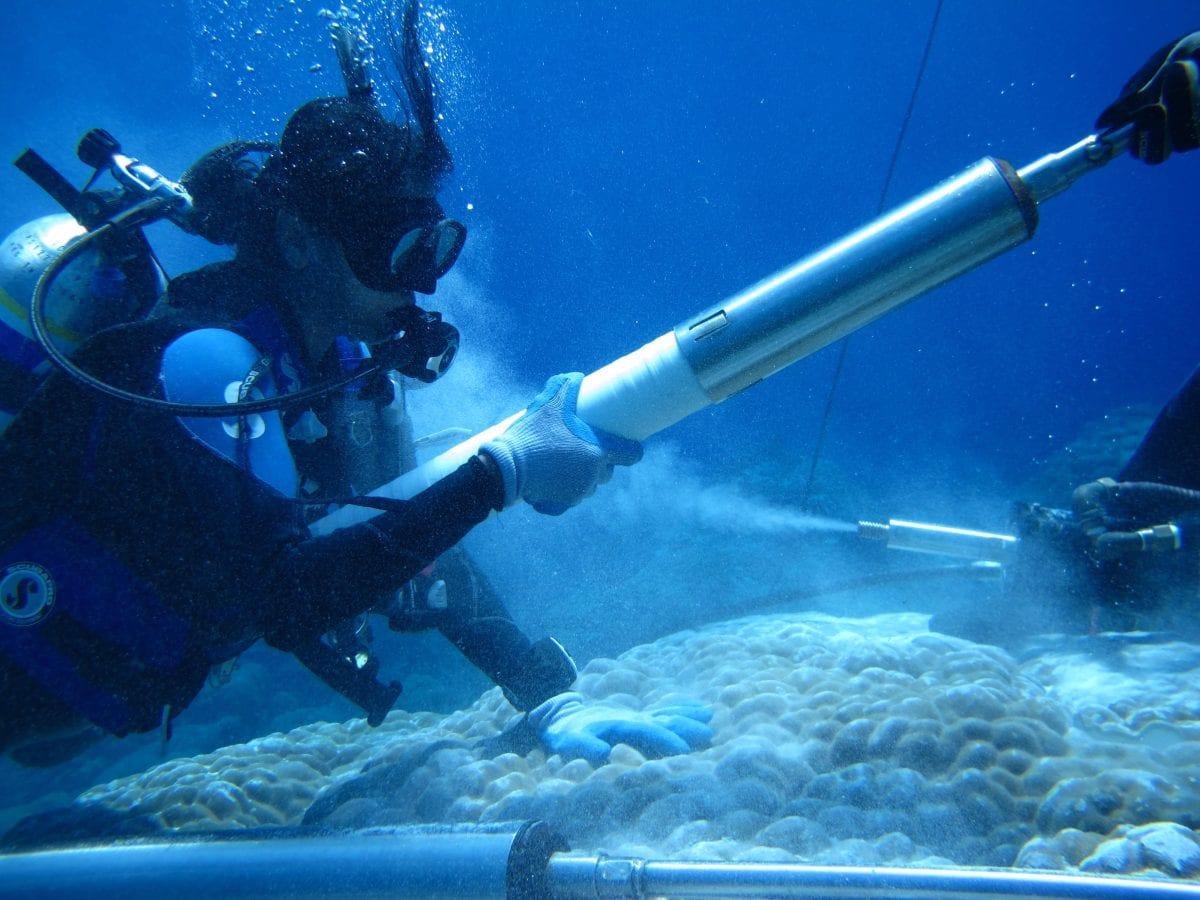The Indian Ocean has been experiencing a higher level of warming than other ocean basins for the past five to six decades.
 Co-author Sujata Murty retrieving a coral core piece during the underwater drilling process. Image Credit: Justin Ossolinski.
Co-author Sujata Murty retrieving a coral core piece during the underwater drilling process. Image Credit: Justin Ossolinski.
While the basin-wide temperature variation can be unequivocally related to the human-induced climate change, it is challenging to verify whether the heat and freshwater changes since 1980 constitute an anthropogenically-forced transformation of the hydrogen cycle.
Several factors such as regional-scale trends, factoring in natural variations, climate model uncertainties, short observational records and the complex circulation of the ocean basin have been hampering the assessment.
A new study takes a detailed look into the consistency of heat and freshwater changes concerning the increase in rainfall, which is expected as a result of anthropogenic global warming. The study also focuses on other suspected causes like natural variability on multi-decadal and other timescales including various other factors.
That difference has “big implications for climate risk assessment and for the densely populated regions around the Indian Ocean that are vulnerable to the effects of climate change,” stated Caroline Ummenhofer, lead author of the study titled “Heat and freshwater changes in the Indian Ocean region” published in the journal Nature Reviews Earth & Environment.
According to Ummenhofer, the research integrates various scientific expertise, tools and data sources to address important questions on climate change in the Indian Ocean.
The different scientific communities need to come together and have very open discussions about what we can tell from our data, how we can compare apples and oranges, and how we can bring all of this information together to have a better understanding of the entire Indian Ocean system.
Caroline Ummenhofer, Study Lead Author and Associate Scientist, Physical Oceanography Department, Woods Hole Oceanographic Institution
According to Janet Sprintall, co-author of the study and a research oceanographer at the Scripps Institution of Oceanography, University of California San Diego, “Rather than rely on climate models that struggle to accurately represent the complex circulation, we look at many different observational records including measurements of sea level, and the ocean surface and subsurface temperature and salinity.”
A few changes in the Indian Ocean are found to be caused by anthropogenic global warming.
In general our ocean observational records are still far too short to distinguish the naturally driven variability from the man-made changes. This tells us that we need to continue measuring our oceans — particularly below the surface — so that we can better understand these long-term changes and their causes, and so that we can improve our prediction and response to them.
Janet Sprintall, Study Co-Author and Research Oceanographer, Scripps Institution of Oceanography, University of California San Diego.
Determining the variations in the Indian Ocean heat and freshwater balance requires a multi-pronged technique spread over temporal and spatial scales and combining in situ observations (including Argo floats robotically programmed to measure ocean temperature, salinity and other properties, moorings and buoys), enhanced numerical modeling simulations, remote sensing by satellites to measure rainfall and sea surface salinity and paleoclimate proxy networks.
Corals form a key paleoclimatic archive in the ocean, as they hold the chemical properties of past climate in their calcium carbonate skeletons. Thus, the coral can project past climate and environmental conditions.
Corals are unique environmental archives that allow us to extend our understanding of Indian Ocean variability centuries farther back in time than the observational record.
Sujata Murty, Study Co-Author and Assistant Professor, Department of Atmospheric and Environmental Sciences, University at Albany, State University of New York
Sujata Murty is also an adjunct scientist at the Woods Hole Oceanographic Institution.
“Including the long-term perspective provided by corals alongside that of observations and remote sensing data enriches our understanding of complex climate and ocean systems and improves our ability to anticipate future changes in a warming world,” added Sujata Murty.
According to the paper, maintenance and expansion of available remote sensing, in situ observations, and a series of paleo proxies are “crucial” for “disentangling the effects of multi-decadal natural variability and anthropogenic change on heat and freshwater changes” in the Indian Ocean and the Maritime Continent areas between Indian and Pacific Oceans.
With respect to the Indian Ocean, the study states that it “is particularly vulnerable to anthropogenic climate change,” in parts as the Asian continent borders the ocean in the north. This feature implies that the heat transferred from the Pacific Ocean to the Indian Ocean via the Indonesian seas cannot easily move out of the basin.
The basin “could be a kind of canary in a coal mine,” stated Ummenhofer, noting that the current changes in the Indian Ocean can also reflect in other oceans.
“We can all benefit from having better observations and a better understanding of the ocean so that we can know whether the changes are a climate change signal or part of a natural cycle,” concluded Ummenhofer.
The study was financially supported by the WHOI Postdoctoral Scholar Program, the U.S. National Science Foundation, the Australian Research Council, the Andrew W. Mellon Foundation Award for Innovative Research, and the James E. and Barbara V. Moltz Fellowship for Climate-Related Research.
Journal Reference:
Ummenhofer, C. C., et al. (2021) Heat and freshwater changes in the Indian Ocean region. Nature Reviews Earth & Environment. doi.org/10.1038/s43017-021-00192-6.